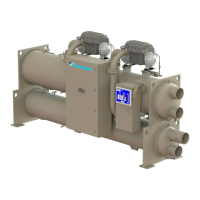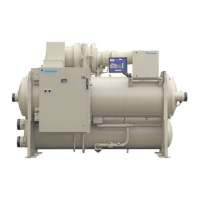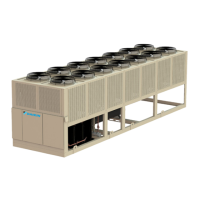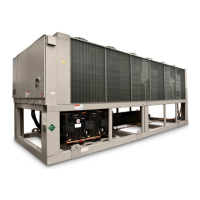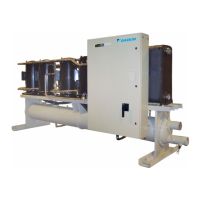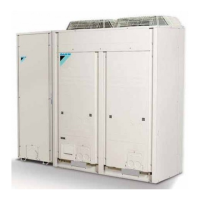5
IOM 1264-4
WWW.DAIKINAPPLIED.COM
INSTALLATION
Installation
Operating Limits
Table 1: WWV Operating/Standby Limits
Operating/Standby Limit Temperature
Maximum mechanical room ambient tem-
perature during chiller operation
113°F (45°C)
Maximum mechanical room ambient
temperature during chiller storage - with
maximum non-condensable relative hu-
midity of 95%
122°F (50°C)
Evaporator outlet uid temperature setpoi-
int range - Cool Mode
25.0°F (-3.9°C) to 77°F
(25°C)
Evaporator outlet uid temperature requir-
ing glycol
< 40°F (4.4°C)
Maximum uid temperature in evaporator
for startup
109.4°F (43°C)
Range of evaporator and condenser uid
temperature change across vessels
Condenser Single Pass
and Evaporator 2 Pass:
7.2°F (-13.8°C) to
14.4°F (-9.8°C)
Condenser 2 Pass:
10°F (-12.2°C) to 40°F
(4.4°C)
NOTE:
Contact a Daikin Applied representative for performance at specic
operating conditions, as some limits depend on unit conguration
Nameplates
The unit nameplate is located on the exterior of the Unit Power
Panel. Both the Model No. and Serial No. are located on the unit
nameplate; the Serial No. is unique to the unit. These numbers
should be used to identify the unit for service, parts, or warranty
questions. This plate also has the unit refrigerant charge and
electrical ratings. Evaporator data plate is under insulation and
contains the serial number. Compressor nameplate is located on
each compressor and gives pertinent electrical information.
WARNING
Installation is to be performed by qualied personnel who are
familiar with local codes and regulations.
CAUTION
When around sharp edges, wear appropriate Personal Protective
Equipment (PPE), such as gloves, protective clothing, foot wear,
eye protection etc. to prevent personal injury.
Inspection
Check all items carefully against the bill of lading. Inspect all units
for damage upon arrival. Report shipping damage and le a claim
with the carrier. Check the unit nameplate before unloading,
making certain it agrees with the power supply available. Daikin
Applied is not responsible for physical damage after the unit
leaves the factory.
Unit Placement
NOTICE
Navigator chillers are designed for indoor installation only.
Indoor installations must be in a structure with a permanent oor
and roof. The unit must be enclosed by walls for protection from
weather conditions.
The unit must be mounted on a level cement or steel base,
suitable to support the overall weight of the complete machine
in operation, and must be positioned so as to provide space for
maintenance at one end of the unit, to allow the cleaning and/
or the removal of the evaporator and the condenser tubes. The
condenser and evaporator tubes are expanded inside the tube
sheets to allow replacement, if necessary.
The machine position should be designed to ensure access to all
the safety and control devices. Never cover the safety devices
(safety valves, pressure switches). The safety valves must be
connected externally.
These units include the installation of safety valves for each
exchanger, installed on an exchange tap, which always maintains
an active valve. Thus, safety valves must be connected outside
of the equipment room.
Mounting Hole Access
After positioning, the shipping rails should be removed and the
machine must be rmly anchored to the ground or foreseen metal
structure to support the machine. In this regard, 0.87 in (22 mm)
diameter holes are included on the unit supports for securing
mounting bolts, etc. Mounting location dimensions are given in
Dimensional Drawings beginning on page 22. When mounted,
the base of the unit must be level to within ± ½ inch (12.7 mm)
across the length and width of the unit.
Service Access
The control panels are located on the front of the chiller and
require a minimum of four feet of clearance in front of the panels.
DANGER
Disconnect, lockout and tag all electrical power to the unit before
servicing compressors and/or recovering refrigerant. Failure to
do so can cause bodily injury or death.
Clearance Requirements
The unit must be placed in an area that allows for adequate
clearance around the unit. Doors and removable wall sections
can be utilized to meet these clearance requirements. There
must be a minimum of 3 to 4-feet clearance above the top of the
chiller. The U.S. National Electric Code (NEC) or local codes can
require more clearance in and around electrical components and
must be checked for compliance.
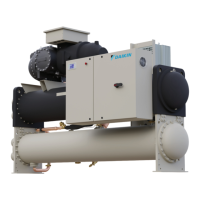
